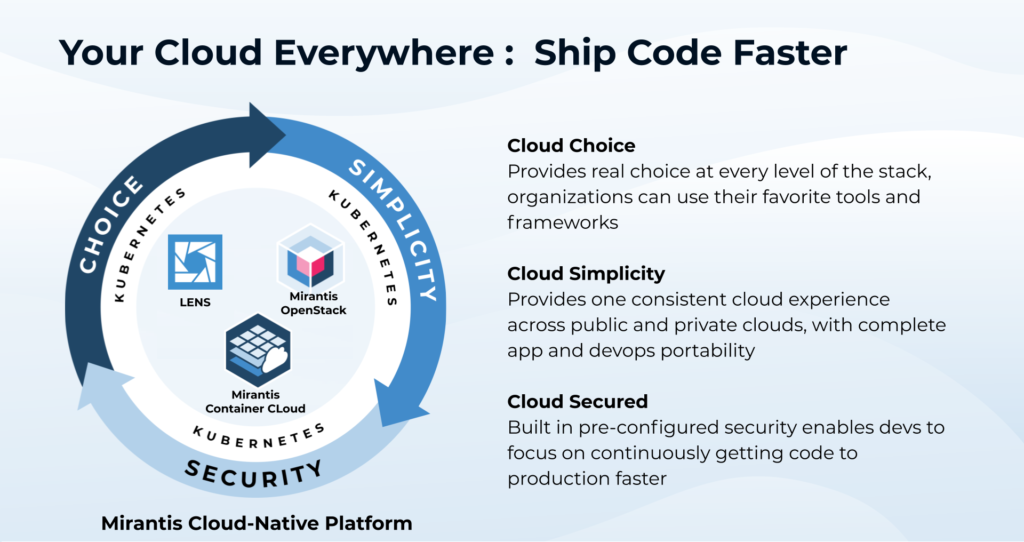The post Announcing Mirantis OpenStack for Kubernetes appeared first on Mirantis | Ship Code Faster.
Today, Mirantis announced the general availability of Mirantis OpenStack for Kubernetes, a new offering now included in the Mirantis Cloud Native Platform. Existing users of Mirantis Container Cloud (formerly Docker Enterprise Container Cloud) will automatically receive the update, which lets them deploy containerized OpenStack control planes, Ceph storage, and compute hosts on Mirantis Kubernetes Engine (formerly Docker Enterprise/UCP).
What does this announcement mean?
Easy to use, resilient private clouds – Pragmatically, it means customers can use Mirantis Cloud Native Platform to air-drop classic private cloud capacity anywhere they have physical host capacity to run it (such as bare metal datacenters at HQ; distributed server farms at satellite locations; colos; medium-scale ‘edge’ server racks, etc. And then it lets them manage, observe, scale, and update this capacity via the same, smooth, public-cloud-like, centrally-administered, continuously-updated, self-service-oriented user experience Mirantis Container Cloud wraps around Kubernetes clusters.
In fact, if someone needs easy, self-service delivery of dev/test/production Kubernetes clouds in tandem with classic, mature virtual-machine hosting capability, they can use Mirantis Container Cloud to deploy Mirantis OpenStack, and then again to deploy Mirantis Kubernetes Engine clusters on virtual machines managed by OpenStack. Given the bare metal capacity, there’s probably no easier, faster way to bootstrap private infrastructure-as-a-service and use it to deliver dynamic container orchestration capability.
OpenStack — product of one of the world’s largest and most formidable open source communities — just celebrated its tenth anniversary. The Register and others marked the occasion with articles discussing the framework’s dominance in telecommunications, where it’s a preferred host for Network Functions Virtualization workloads, among other fields. OpenStack is today a very mature IaaS cloud solution that’s remarkably easy to use — complete with a sleek web interface (Horizon) and comprehensive APIs.
Why OpenStack on Kubernetes?
Using Kubernetes as a substrate for OpenStack solves “challenges” historically associated with running big, production OpenStack clouds (some of which will sound familiar to Kubernetes users).
MOS clusters leverage native Kubernetes features for resilience and adaptability. They use K8s operators to maintain cluster state, horizontal pod autoscaling to expand control-plane capacity under load, and seamless, zero-downtime Kubernetes rolling updates of OpenStack and other components. Containerized OpenStack components execute on Mirantis Container Runtime (formerly Docker Engine – Enterprise), which provides DISA STIG security, FIPS-140-2 encryption, and other characteristics making them suitable for use in gov/mil, financial services, and other regulated sectors.
Mirantis Cloud Native Platform delivers Mirantis OpenStack for Kubernetes the same way it does Mirantis Kubernetes Engine child clusters: ready for work, centrally administered, observed, and with Mirantis Container Cloud providing a single point of integration with corporate directory and other services. Mirantis OpenStack for Kubernetes clusters are delivered pre-instrumented and integrated with StackLight metrics, so users get observability out of the box. Mirantis Container Cloud also provides a single point of integration with enterprise directory, notifications, ticketing, etc., and top-level identity and access management, so Mirantis OpenStack clusters can be delivered with users, teams, tenants, SSH keys, etc. already provisioned for immediate use and secure access.
Kubernetes: Zamboni for the Multi-Cloud Hockey Rink
Mirantis OpenStack for Kubernetes also proves a point that Mirantis has embraced (and debated) internally for several years: that Kubernetes can work very well as a substrate for delivering and managing complex and even reputedly “tricky” applications, while giving users maximum choice in where their applications run.
As Shaun O’Meara, Global Field CTO at Mirantis, says in the press release: “Kubernetes and containers are superior technologies for building and releasing applications that run anywhere, scale gracefully, are resilient, and that can be updated without service downtime.” A modern workload constellation like containerized OpenStack can leverage Kubernetes directly for performance (for example, by scaling control-plane components out, horizontally, to deal with particular kinds of bursty load); resilience; optimal scheduling; failed-workload restarts; operator-based storage management; etc., and draw on its built-in lifecycle management features and associated best-practice for managing updates with zero or minimal impact on service availability.
And Kubernetes — or at least, Mirantis Kubernetes Engine: a Kubernetes distribution engineered to have minimal dependencies on host and OS — can “manage down” as well. For Mirantis Cloud Native Platform and Container Cloud, this means simpler, more reliable, and more highly-optimizable logic for managing bare metal, and for addressing the particular requirements and opportunities presented by private- and public-cloud substrates.
In short, Kubernetes means managing the whole stack more reliably, and delivering that seamless, simple, cloud experience for managing Kubernetes (and now OpenStack, and soon other enabling technologies) across the multi-cloud.
Early Adopters Show the Way
Current Mirantis OpenStack customers are enthusiastically evaluating and working with Mirantis OpenStack on Kubernetes, which lets them improve the efficiency and agility of their OpenStack private cloud implementations while also gaining a unified model for providing Kubernetes (and Swarm) orchestration across the multi-cloud. Several are also using Mirantis OpenStack to host Kubernetes clusters used as foundations for platform-as-a-service, serverless computing, and similar frameworks.
Enterprises, financial services, and other orgs are also using Mirantis OpenStack for Kubernetes to resource-manage high performance computing on bare-metal OpenStack compute nodes, using this capacity for machine-learning, big data analytics, media processing, and other initiatives. Mirantis Container Cloud, OpenStack, and Kubernetes give these organizations great flexibility to allocate compute dynamically and share expensive hardware economically among jobs, projects, and teams.
Infrastructure and service providers, meanwhile, are adopting Mirantis OpenStack for Kubernetes as a foundation for ambitious public IaaS offerings, as well as initiatives providing centralized infrastructure for managing large fleets of IoT devices and the data and transactional loads they generate. Telco operators are applying Mirantis OpenStack for Kubernetes for hosting NFV workloads, and for new trials around 5G edge computing.
To schedule a live demo of Mirantis OpenStack for Kubernetes, click here.
The post Announcing Mirantis OpenStack for Kubernetes appeared first on Mirantis | Ship Code Faster.
Quelle: Mirantis

Published by